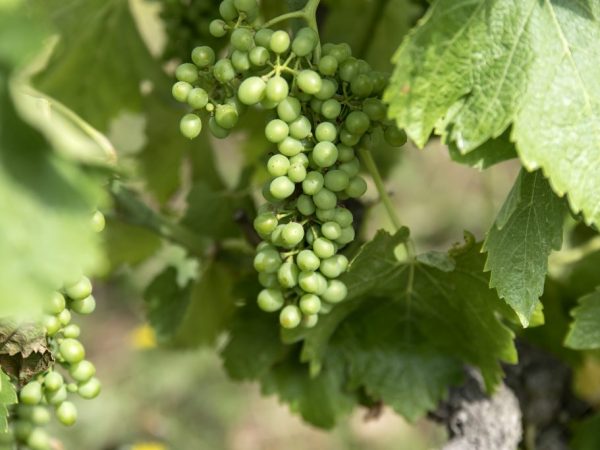Grape variety Russian early
Russian early grape is a dessert table variety. Its main advantage is early ripening.

Grape variety Russian early
Characteristics of the variety
After bud formation, grapes ripen within 100-115 days. This dessert variety is recognized as a high-yielding variety, since the clusters are large, with a large number of berries. During the harvesting period, one bush of the plant has up to 20 kg of ripe fruits.
Description of the bush
The early Russian grape variety, according to the description, differs in the thickness of the wood. Because of this feature, it bears a small amount of fruit during the first 5 years after planting.
The bush of early Russian grapes grows over time in width up to several meters. During the ripening of the fruit, the leaves of the plant are heart-shaped.
Russian early grapes are pollinated without the help of insects.
Description of the fetus
The berries of the early Russian plant are medium in size and oval in shape. One fruit weighs up to 8 g. Ripe berries have a pink and burgundy color with a pearlescent bloom. This variety tastes sweet, without acid.
The fruits tolerate transportation well. They stay on the bush for a long time, but after overripe, they quickly lose their elasticity.
Care
The bush is grown in optimal areas, but with proper care, it also bears fruit in non-traditional areas for it.
The main rule when growing this plant is area and light. In darkened areas, the plant is not able to take root. It is worth systematically removing dead branches so that they do not take moisture and strength from healthy shoots.
Watering
The plant needs proper watering. It is of two types:
- moisture charging;
- vegetative.
Water-charging plants are irrigated seasonally: in spring and autumn. Spring watering is carried out before the grape leaves begin to bloom. This care nourishes the plant with moisture and gives it the strength to create leaves and healthy bunches.

Proper watering is important for the plant.
Autumn watering is carried out at above-zero temperatures. The plant's tolerance to frost depends on it. With optimal moisture content, the grapes will be protected from freezing during sub-zero temperatures.
In summer, grape bushes are watered no more than 2-3 times per season, since a large amount of moisture in the stems leads to the appearance of low-quality fruits. During watering, 10-12 liters of water are used per bush.
Top dressing
The early Russian grape variety exists without seasonal dressings, but when they are used, the wood becomes more stable, and the amount of harvest grows every year.
Plants are fertilized in early spring before the buds ripen, so that the bush can receive all the necessary nutrients. Manure and bird droppings are used as fertilizers.
Bush formation
A healthy mature shrub can be several meters wide. Unnecessary branches should be systematically trimmed in order to spur the formation of fruit clusters. Pruning is carried out in early spring so as not to injure the vine.The cut points are sprinkled with charcoal.
Diseases and pests
The early Russian grape variety is not attacked by seasonal ticks and other insects, therefore it does not need chemical treatments.
With a lack of sunlight and heat, the plant is prone to rotting, so it is important to plant it in the correct area.
Despite the resistance of the grape bush to pests, it must be seasonally treated with fungicide solutions. You can prevent the appearance of diseases if you follow some rules:
- produce seasonal watering;
- feed plants in spring and autumn;
- provide the bushes with the optimal amount of light and heat.
Conclusion
Russian early grapes, according to the description, are unpretentious in care. However, for good fertility, the variety needs regular watering and feeding.
This grape variety is not planted in areas with frequent precipitation: they injure the fruit. Seasonal watering in the right amount will provide the shrubs with optimal protection from the cold and sufficient moisture at elevated temperatures.

